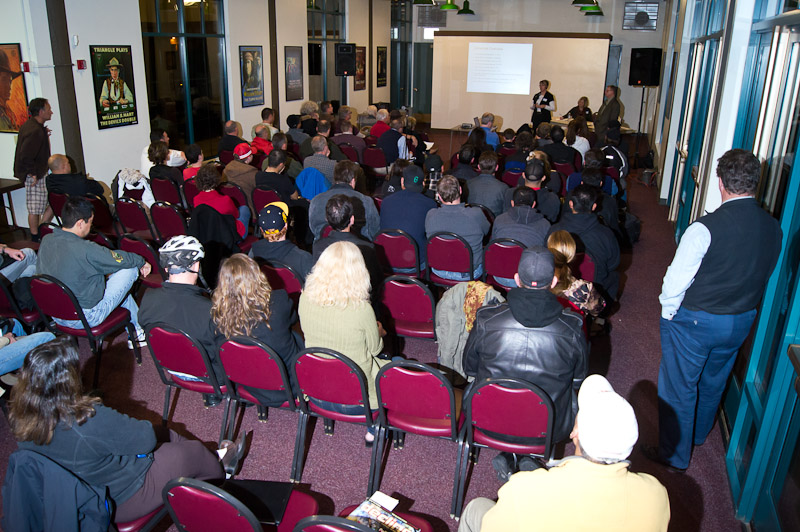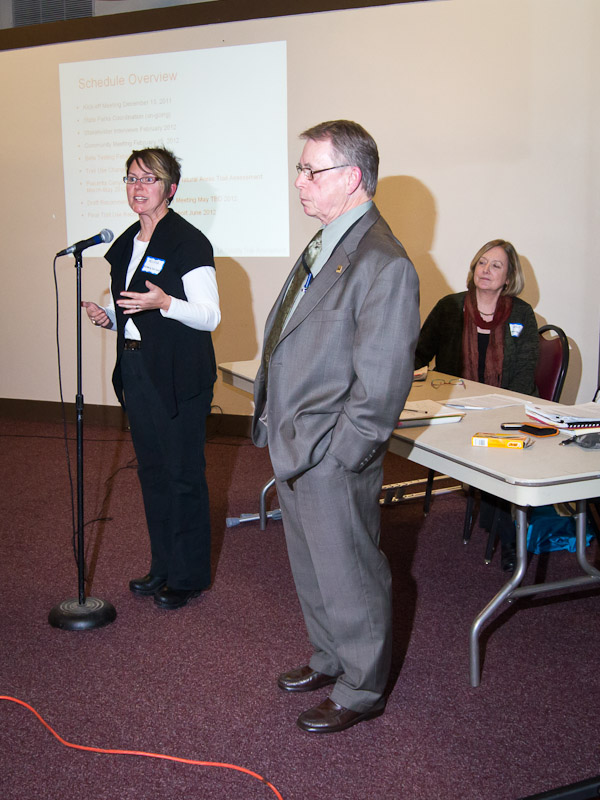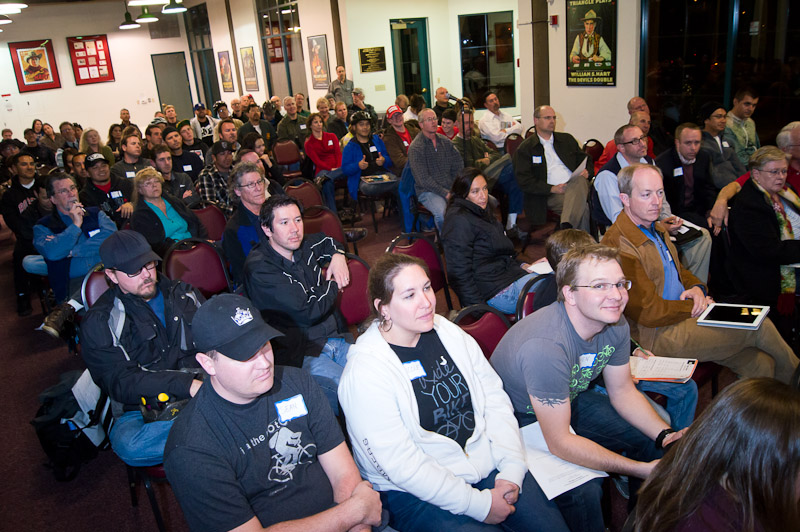On February 15, 2012, more than 80 people gathered at Hart Park Hall in Santa Clarita Valley to hear and weigh in on the County’s plans. Of those 80 or more people, more than 70 identified themselves as mountain bikers. The SCV Trail Users did an outstanding outreach effort to get people to come to the meeting. Many brought helmets, identifying themselves as off-road cyclists. The closure of the Canyon trail in Placerita Nature Center to bicycles has united the cycling community in the area.
The meeting was being conducted by DCE Planning, the contractor retained by the County to perform the trail assessment and make a recommendation. After a brief round of introductions by Melissa Erikson, Sarah Sutton gave background on DC&E’s experience related to trails and planning and the trails assessment process they will be using. Stephen Copely is the non-motorized trails manager for the fifth district, and will be the contact person for the County as the process moves forward, though he did not speak during the meeting.
Melissa then gave some background of the DOJ ruling from March 2011 regarding accessibility and ADA compliance, which is her specialty. There’s a lot of misunderstanding about this DOJ ruling. Trail and open space managers must allow personal mobility devices–which in the broadest interpretation could mean anything from quads to motorcycles to segways to wheelchairs–on any trail that pedestrians/hikers are allowed, unless they can show a “good reason” they shouldn’t be allowed. In order to show a good reason, an objective assessment of the trail is needed. Essentially the assessment will kill two birds with one stone: determining the feasibility of personal mobility devices for the disabled and permitted uses on a trail.
Currently, DC&E and the County will be reviewing three trails: the Canyon Trail and Los Pinetos trail in Placerita Canyon Natural Area, and the History trail in Vasquez Rocks Natural Area. While Los Pinetos trail is currently open to bikes, it will be evaluated as well. Larry Hensley, chief of planning for LA County Parks, also commented that in time all the designated County trails in the fifth district will be assessed. One of the outcomes, he said, will be the creation of an online trail information resource where the public will be able to find out the details about any County trail.
Hensley also spoke to the inconsistency within their natural area management. Presently, a Natural Area manager can open a trail to bikes–or close one–at their sole discretion. The assessment tool will give managers an objective criteria for opening or closing a trail to certain uses. This could be key to gaining bicycle access in Natural Areas, where the objective findings of the trail assessment deem it possible. Several times during the meeting the County’s multi-use goals were emphasized. Their goal is to get more people on trails, not less. Some in the audience commended the County on their long history of multi-use policy including bicycles, dating back to the early ’90’s.
The County is using the State’s assessment tool. This tool requires a foot-by-foot on-the-ground comprehensive measurement of width, surface, ruts, soil type, visibility, grade, outsloping, connectivity, stability, cultural and natural resources. It is a standardized and objective process that will be used to establish policy. The same process will be applied to all trails and all users, providing consistency across the trail system. The State is still developing the assessment tool, and the County/DC&E’s use of the tool will be part of the State’s peer review and beta testing of the process.
Ms. Erikson then outlined the results of their outreach to existing stakeholder groups. She noted the commonly shared visions of each group in preserving trail access, improving safety, and minimizing environmental impacts. She made an astute observation, saying that “Safety is an observable component, while conflict is perceived.”
The meeting attendees spent the next 90 minutes asking questions and making comments. The audience, almost entirely mountain bikers, asked many intelligent questions and represented the cycling community well. Questions were raised about the timeline, the need for Environmental review, the possibility of alternate use days, funding, and many other concerns. If major changes to a trail such as a re-route are recommended, these will require a CEQA process. Some expressed the willingness of the cycling community to do any trailwork that is needed or recommended for which there are no funds to complete.
There appeared to be some confusion as to the “trail survey” that was mentioned. This is synonymous with the on-the-ground “trail assessment” and doesn’t refer to a survey of trail users. However, trail users were encouraged to document conflicts by reporting them, or to document their satisfaction with the trails in question.
Sustainability of the trail is one of several components of the assessment. Audience members wondered how five years of use by bicycles hasn’t resulted in a degradation of the Canyon trail, and wondered if this history would be considered. With equestrian impacts to trails known to be greater than bicycles, there was frustration and misunderstanding about what “sustainability” means in this context.
Jim Hasenauer of IMBA spoke eloquently about some of the concerns raised by this process. He observed that the real issue is mountain bike access and the closure of the Canyon trail, separate from the DOJ ruling. The County is lumping them both together, though they could have been handled separately. He went on to say “The reality of trail users is that we really vary in our inclination and abilities. A trail that barely exists to some…is well within the ability and interest of others.” Having a minimum design standard as a criteria for use would be a mistake and a dis-service to the range of desired experiences sought out by trail users. Indeed, the homogenization of trails that may result from having such a minimum design standard would decrease the range of opportunities for all trail users. Hasenauer continued that with all outdoor recreation, “progression is a part of the sport, and people need a range of difficulties of trails in order to progress.” People think they can “engineer a trail to eliminate user conflict, but that doesn’t work and results in unsatisfactory trails for all.” He received a solid round of applause for his comments.
He went on to remark that bikes have been using the Canyon trail for some time, with very few documented cases of conflict. For the public, there is little or no distinction between a natural area and an open space. They look like each other, and the public doesn’t care, as long as there are trails available to enjoy the resource. Bicyclists are the only group that have been disadvantaged by this process and by recent closures. The mountain biking community has been patient and cooperative, and need to be acknowledged for their willing participation in this process. Responsible riders on a multi-use trail are the most important ambassadors for and enforcers of good trail etiquette.
While at this point the Canyon and History trails are closed to bikes, the Los Pinetos trail is not. This trail provides important connectivity with Forest Service trails and is a part of a larger and quite popular loop from Santa Clara Truck Trail. That loop also included the Canyon Trail until it was closed. Retaining this connectivity will be especially important, and comments must be submitted to that effect.
The process is now underway, and we have seen what the State is doing to further develop and test the assessment tool. We recently posted a report about the Tapia Spur trail that is presently being upgraded after undergoing an assessment using the tool. DC&E expects to complete the on-the-ground assessment of these three trails over the next two months, and will release a draft recommendation sometime in May. After the public is given an opportunity to review and comment on the draft, a final recommendation will be made to the County Parks and Recreation Department and ultimately the Board of Supervisors.
Until the draft is released, the cycling community needs to stay engaged within the trail user community, and continue building relationships with the County and other trail user groups. It will be important for everyone concerned to review that draft recommendation and comment accordingly. The County expects to have a summary of this meeting available online in the coming weeks. Once it is made public, we encourage everyone to submit their preliminary comments to the County.
Tags: Canyon Trail, LA County, Los Pinetos, Placerita Canyon, Santa Clarita Valley






